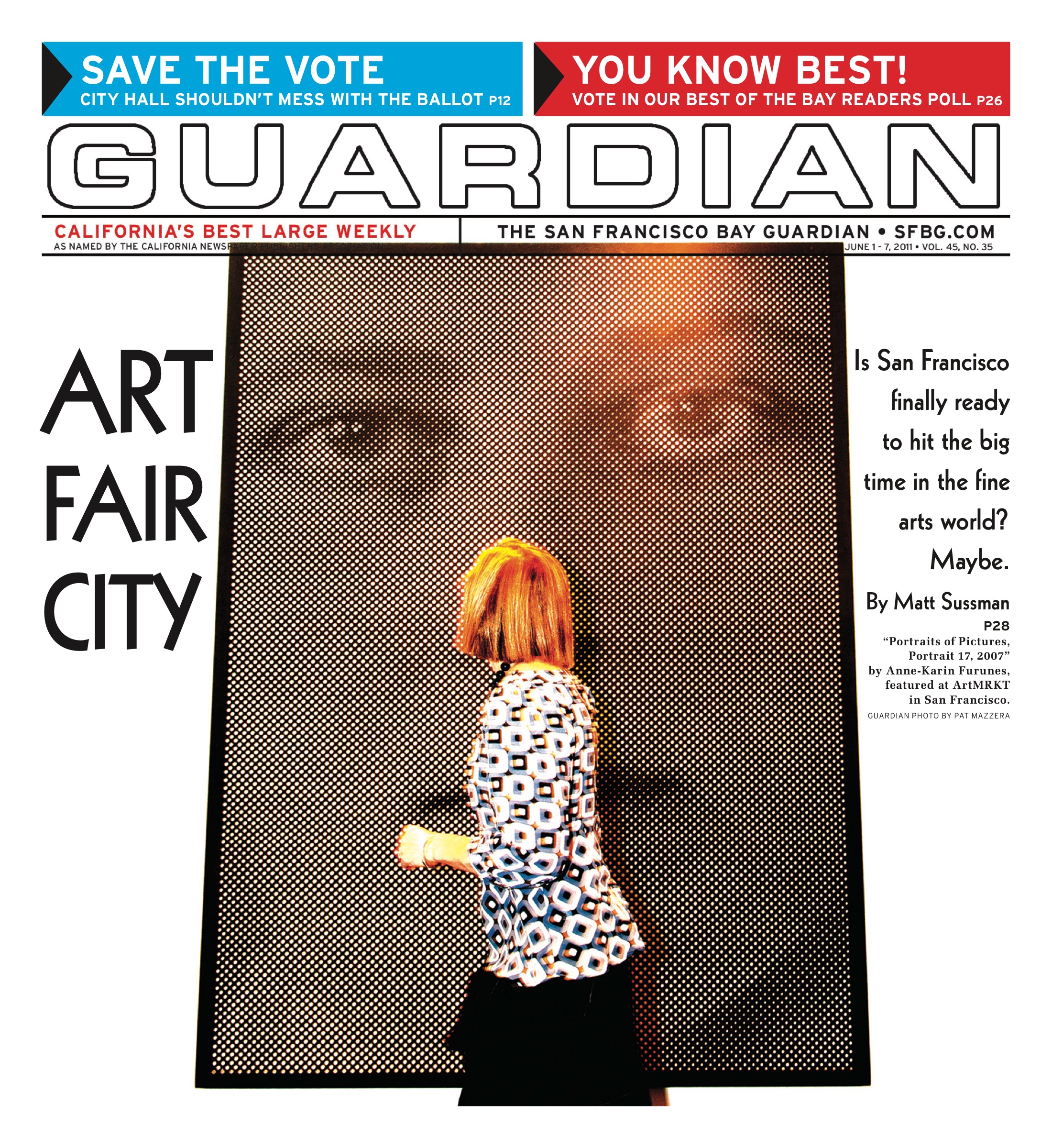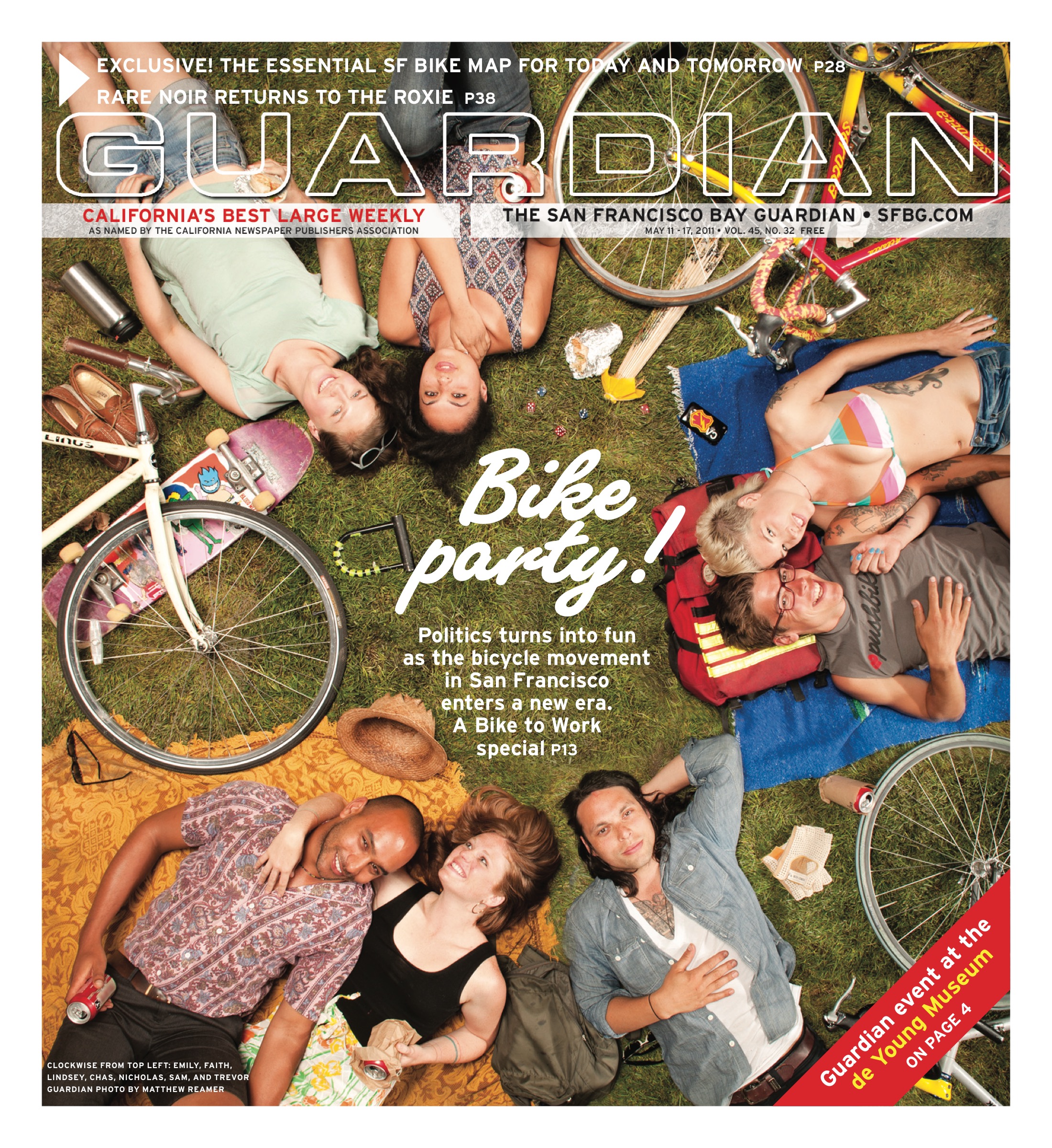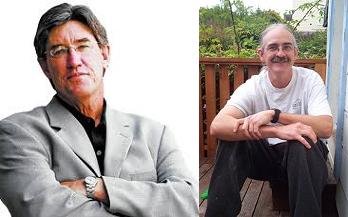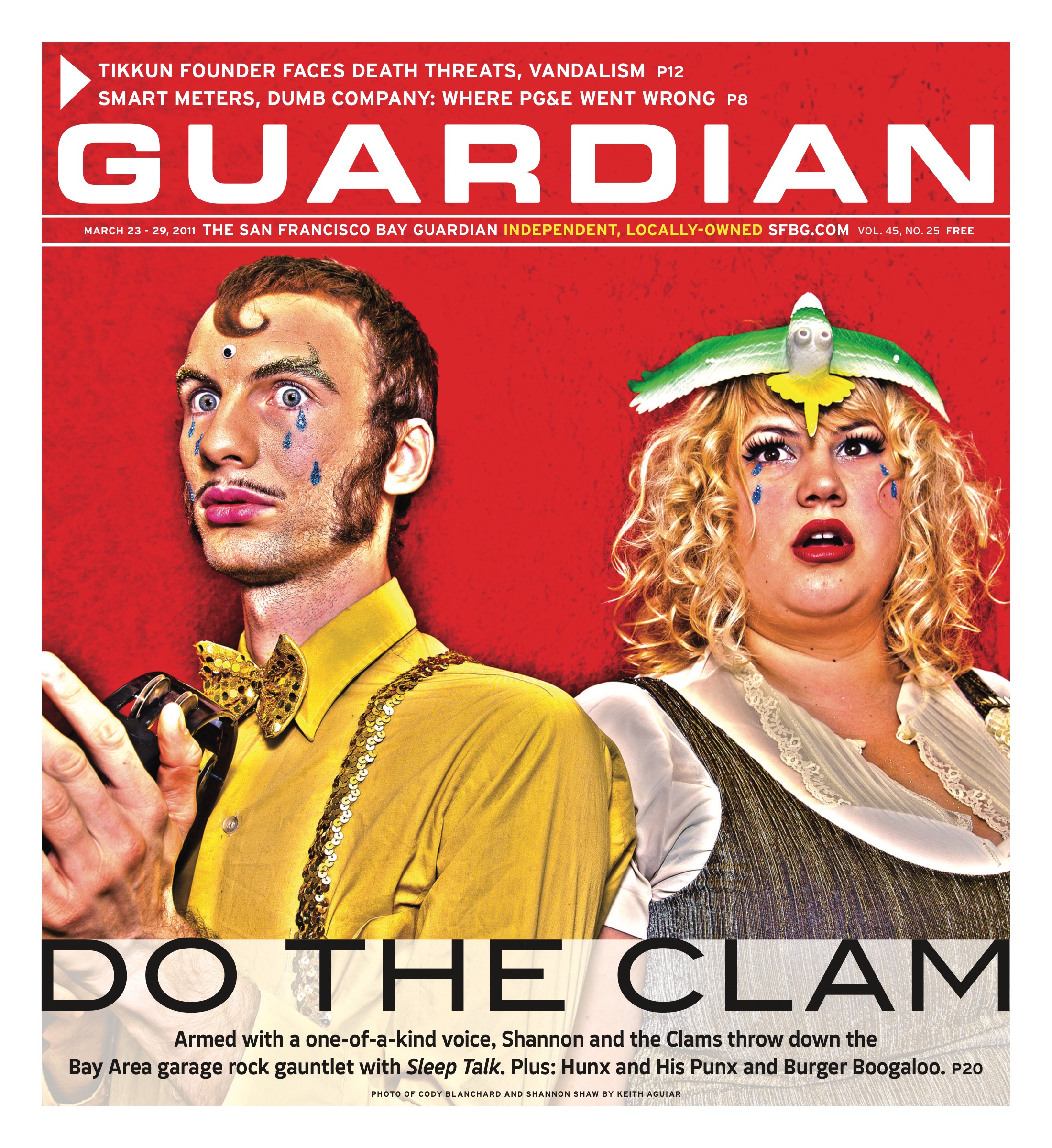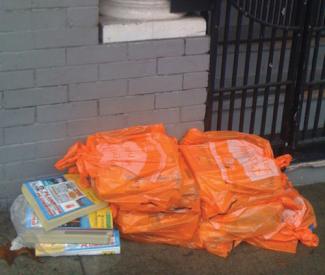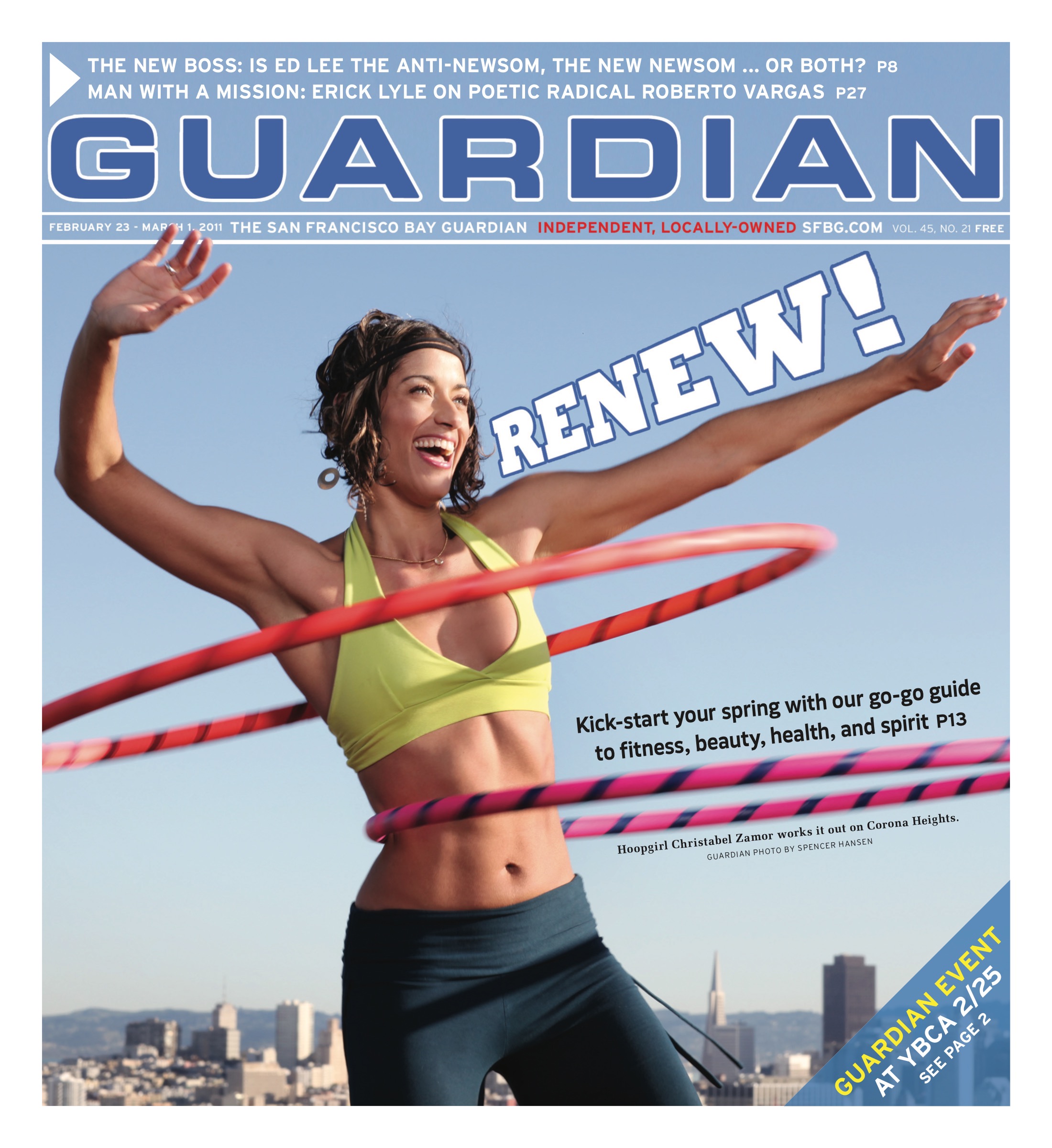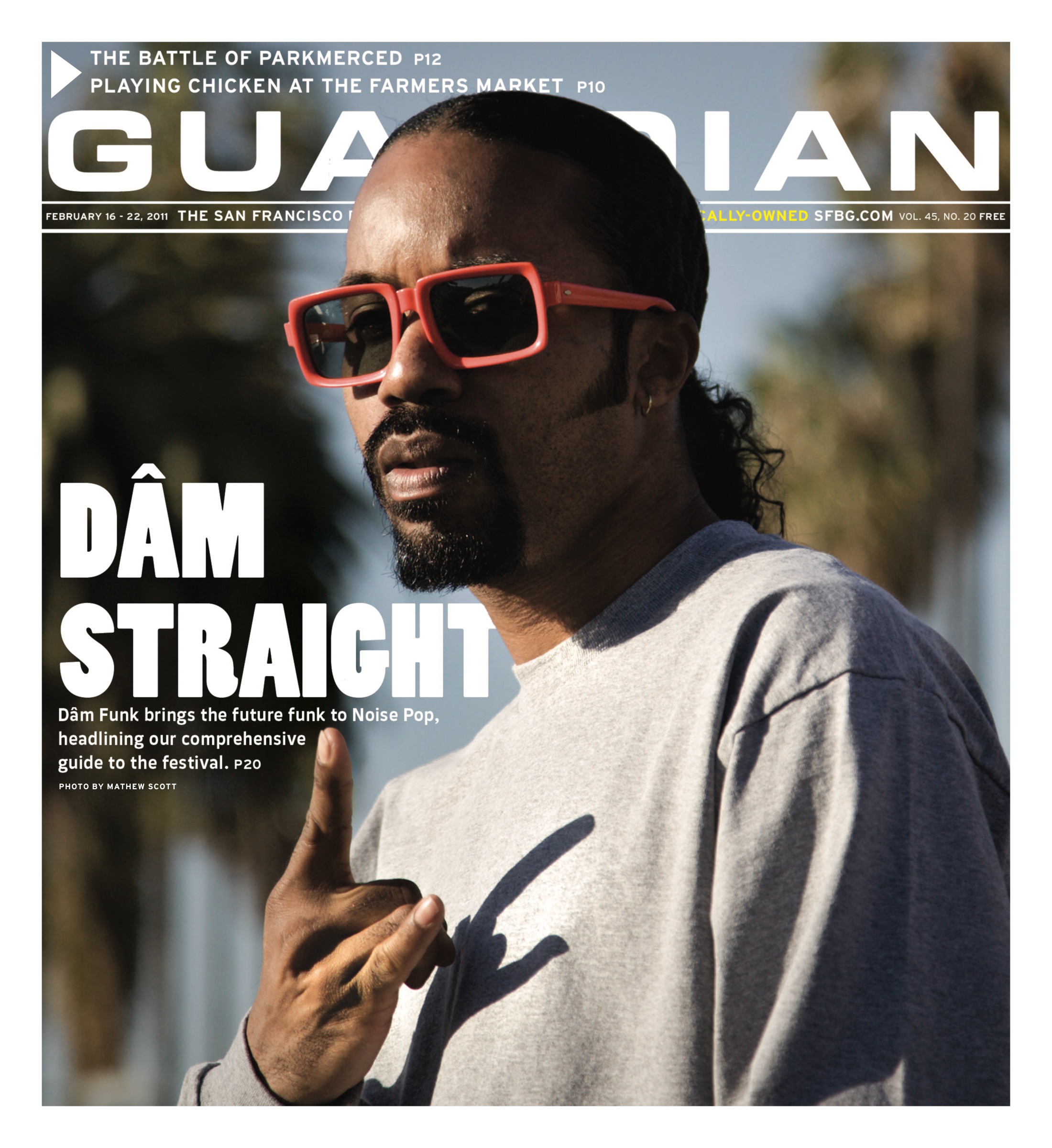WEDNESDAY 9
ROCK/BLUES/HIP-HOP
Castanets, Holy Sons, Dolorean Hemlock Tavern. 9pm, $8.
Dears, Eulogies, Tender Box Slim’s. 8pm, $16.
Damien Jurado, Viva Voce, Campfire OK Bottom of the Hill. 9pm, $12.
Guverment, Curse of Panties, One Over Eight Red Devil Lounge. 8pm, $6.
Red Hot Blues Sisters Biscuits and Blues. 8 and 10pm, $15.
Sabertooth Zombie, Owen Hart, Xibalba, Grace Alley Thee Parkside. 8pm, $8.
Starfucker, Unknown Mortal Orchestra Rickshaw Stop. 8pm, $15.
Sway Machinery, Khaira Arby Great American Music Hall. 8pm, $16.
Emily Jane White, Hélène Renaut, Ed Masuga Café Du Nord. 9:30pm, $10.
JAZZ/NEW MUSIC
Cosmo Alleycats Le Colonial, 20 Cosmo, SF; www.lecolonialsf.com. 7pm.
Jesus Diaz and the Afro-Cuban Jazz All-Star Ensemble Yoshi’s San Francisco. 8pm, $15.
Dink Dink Dink, Gaucho, Michael Abraham Amnesia. 7pm, free.
Ettie Street Project Madrone Art Bar. 9pm, free.
Ben Marcato and the Mondo Combo Top of the Mark. 7:30pm, $10.
Medeski, Martin and Wood, Edmund Welles: The Bass Clarinet Quartet Independent. 8pm, $30.
“Musical Flora and Fauna” Meridian Gallery, 535 Powell, SF; www.meridiangallery.org. 7:30pm, $10. Performed by David Barnett.
Pocket Jazz Revolution Café, 3248 22nd St, SF; (415) 642-0474. 8:30pm, free.
Paula West and George Mesterhazy Quartet Rrazz Room. 8pm, $35.
FOLK/WORLD/COUNTRY
Chico Trujillo, Bang Data, DJ Juan Data Elbo Room. 9pm, $10-12.
DANCE CLUBS
Booty Call Q-Bar, 456 Castro, SF; www.bootycallwednesdays.com. 9pm. Juanita Moore hosts this dance party, featuring DJ Robot Hustle.
Cannonball Beauty Bar. 10pm, free. Rock, indie, and nu-disco with DJ White Mike.
Jam Fresh Wednesdays Vessel, 85 Campton, SF; (415) 433-8585. 9:30pm, free. With DJs Slick D, Chris Clouse, Rich Era, Don Lynch, and more spinning top40, mashups, hip hop, and remixes.
Mary-Go-Round Lookout, 3600 16th St, SF; (415) 431-0306. 10pm, $5. A weekly drag show with hosts Cookie Dough, Pollo Del Mar, and Suppositori Spelling.
No Room For Squares Som., 2925 16th St, SF; (415) 558-8521. 6-10pm, free. DJ Afrodite Shake spins jazz for happy hour.
Respect Wednesdays End Up. 10pm, $5. Rotating DJs Daddy Rolo, Young Fyah, Irie Dole, I-Vier, Sake One, Serg, and more spinning reggae, dancehall, roots, lovers rock, and mash ups.
Synchronize Il Pirata, 2007 16th St, SF; (415) 626-2626. 10pm, free. Psychedelic dance music with DJs Helios, Gatto Matto, Psy Lotus, Intergalactoid, and guests.
THURSDAY 10
ROCK/BLUES/HIP-HOP
Joey Cape, Steve Soto and the Twisted Hearts, Richmond Kid Thee Parkside. 9pm, $10.
Cave Singers, Lia Ices, Triumph of Lethargy Great American Music Hall. 8pm, $15.
Cheap Time, Idle Times, Dead Meat Hemlock Tavern. 9pm, $10.
Data Rock, Dirty Ghosts, Baertur Bottom of the Hill. 9pm, $14.
Jason King Band Biscuits and Blues. 8 and 10pm, $15.
Kill Moi, Silent Comedy, Sporting Life Red Devil Lounge. 8pm, $6.
Miami Horror, Reporter, Boys IV Men, Eli Glad Mezzanine. 9pm, $18.
Wave Array, Ash Reiter, Buckeye Knoll Café Du Nord. 9pm, $10.
JAZZ/NEW MUSIC
Cosmo Alleycats Blondie’s, 540 Valencia, SF; www.blondiesbar.com. 9pm.
Organsm with Jim Gunderson and “Tender” Tim Shea Bollyhood Café. 6:30pm, free.
SF Jazz Hotplate Series Amnesia. 9pm.
Stompy Jones Top of the Mark. 7:30pm, $10.
McCoy Tyner Yoshi’s San Francisco. 8 and 10pm, $25-35.
Paula West and George Mesterhazy Quartet Rrazz Room. 8pm, $40.
Patrick Wolff Revolution Café, 3248 22nd St, SF; (415) 642-0474. 8:30pm, free.
FOLK/WORLD/COUNTRY
Tyler Fortier Café Royale, 800 Post, SF; (415) 641-6033. 8pm, free.
High Country Atlas Café. 8-10pm, free.
DANCE CLUBS
Afrolicious Elbo Room. 9:30pm, $5. DJs Pleasuremaker and Señor Oz spin Afrobeat, tropicália, electro, samba, and funk.
Caribbean Connection Little Baobab, 3388 19th St, SF; (415) 643-3558. 10pm, $3. DJ Stevie B and guests spin reggae, soca, zouk, reggaetón, and more.
Drop the Pressure Underground SF. 6-10pm, free. Electro, house, and datafunk highlight this weekly happy hour.
80s Night Cat Club. 9pm, $6 (free before 9:30pm). Two dance floors bumpin’ with the best of 80s mainstream and underground with Dangerous Dan, Skip, Low Life, and guests. This week, March birthday babies get in free with a guest.
Guilty Pleasures Gestalt, 3159 16th St, SF; (415) 560-0137. 9:30pm, free. DJ TophZilla, Rob Metal, DJ Stef, and Disco-D spin punk, metal, electro-funk, and 80s.
Jivin’ Dirty Disco Butter, 354 11th St., SF; (415) 863-5964. 8pm, free. With DJs spinning disco, funk, and classics.
Kissing Booth Make-Out Room. 9pm, free. DJs Jory, Commodore 69, and more spinning indie dance, disco, 80’s, and electro.
Mestiza Bollywood Café, 3376 19th St, SF; (415) 970-0362. 10pm, free. Showcasing progressive Latin and global beats with DJ Juan Data.
Motion Sickness Vertigo, 1160 Polk, SF; (415) 674-1278. 10pm, free. Genre-bending dance party with DJs Sneaky P, Public Frenemy, and D_Ro Cyclist.
1984 Mighty. 9pm, $2. The long-running New Wave and 80s party has a new venue, featuring video DJs Mark Andrus, Don Lynch, and celebrity guests.
Peaches Skylark, 10pm, free. With an all female DJ line up featuring Deeandroid, Lady Fingaz, That Girl, and Umami spinning hip hop.
Popscene Rickshaw Stop. 10pm, $10. With Blackbird Blackbird, Designer Deejays, and Richie Panic, plus resident DJ Aaron Axelsen.
Thursday Special Tralala Revolution Café, 3248 22nd St, SF; (415) 642-0474. 5pm, free. Downtempo, hip-hop, and freestyle beats by Dr. Musco and Unbroken Circle MCs.
FRIDAY 11
ROCK/BLUES/HIP-HOP
Bone Thugs-N-Harmony Yoshi’s San Francisco. 8 and 10pm, $35.
“Boxwars” Cellspace, 2050 Bryant, SF; www.boxwars.tumblr.com. 8pm, $7. “Violent recycling” plus live music with Bum City Saints, 132, and Not Even a Mouse.
Foolproof 4 Revolution Café, 3248 22nd St, SF; (415) 642-0474. 9pm, free.
Rick McKay and GQ Café Royale, 800 Post, SF; (415) 641-6033. 8pm, free.
North Mississippi Allstars Independent. 9pm, $22.
Pogo, Lynx Slim’s. 9pm, $16.
Joshua Radin, Cary Brothers, Laura Jensen Great American Music Hall. 9pm, $22.
Revolver, Hey Rosetta, 7 Orange ABC Rickshaw Stop. 8:30pm, $10.
Lavay Smith and the Red Hot Skillet Lickers Biscuits and Blues. 8 and 10pm, $20.
Soft Kill, Dangerous Boys Club, DJ Night School Hemlock Tavern. 9:30pm, $8.
Super Diamond, Sun Kings Bimbo’s 365 Club. 9pm, $22.
Tapes ‘n Tapes Amoeba, 1855 Haight, SF; www.amoeba.com. 3pm, free.
Tapes ‘n Tapes, Dale Earnhardt Jr. Jr., Glaciers Bottom of the Hill. 10pm, $16.
Truth and Salvage Co., Pirate Radio, Shants Café Du Nord. 9pm, $12.
• Weedeater, Zoroaster, Kvelertak, Begotten Thee Parkside. 9pm, $12-14.
JAZZ/NEW MUSIC
Black Market Jazz Orchestra Top of the Mark. 9pm, $10.
SF Jazz Collective Herbst Theatre, 401 Van Ness, SF; www.sfjazz.org. 8pm, $25-65. Performing the music of Stevie Wonder.
Paula West and George Mesterhazy Quartet Rrazz Room. 8pm, $45.
FOLK/WORLD/COUNTRY
Valerie Orth, Larry Block, Dana Carmel Dolores Park Café, 501 Dolores, SF; (415) 621-2936. 8pm, $10.
Chuchito Valdez Peña Pachamama, 1630 Powell, SF; (415) 646-0018. 10pm.
DANCE CLUBS
Afro Bao Little Baobab, 3388 19th St, SF; (415) 643-3558. 10pm, $5. Afro and world music with rotating DJs including Stepwise, Steve, Claude, Santero, and Elembe.
Blow Up: Designer Drugs DNA Lounge. 10pm, $20. With Designer Drugs and Jeffrey Paradise.
Club Gossip Cat Club. 9pm, $5-8 (free before 9:30pm). Joy Division tribute night.
Exhale, Fridays Project One Gallery, 251 Rhode Island, SF; (415) 465-2129. 5pm, $5. Happy hour with art, fine food, and music with Vin Sol, King Most, DJ Centipede, and Shane King.
Fubar Fridays Butter, 354 11th St., SF; (415) 863-5964. 6pm, $5. With DJs spinning retro mashup remixes.
Good Life Fridays Apartment 24, 440 Broadway, SF; (415) 989-3434. 10pm, $10. With DJ Brian spinning hip hop, mashups, and top 40.
Heartical Roots Bollywood Café. 9pm, $5. Recession friendly reggae.
Hot Chocolate Milk. 9pm, $5. With DJs Big Fat Frog, Chardmo, DuseRock, and more spinning old and new school funk.
Original Plumbing Elbo Room. 10pm, $6. With dance DJs 100 Spokes and Rapid Fire.
Rockabilly Fridays Jay N Bee Club, 2736 20th St, SF; (415) 824-4190. 9pm, free. With DJs Rockin’ Raul, Oakie Oran, Sergio Iglesias, and Tanoa “Samoa Boy” spinning 50s and 60s Doo Wop, Rockabilly, Bop, Jive, and more.
Some Thing Stud. 10pm, $7. VivvyAnne Forevermore, Glamamore, and DJ Down-E give you fierce drag shows and afterhours dancing.
Vintage Orson, 508 Fourth St, SF; (415) 777-1508. 5:30-11pm, free. DJ TophOne and guest spin jazzy beats for cocktalians.
SATURDAY 12
ROCK/BLUES/HIP-HOP
AC/Dshe, Total B.S., Only Sons Slim’s. 9pm, $15.
Clay Aiken Warfield. 8pm, $34.50-49.50.
Aunt Kizzy’z Boyz Biscuits and Blues. 8 and 10pm, $20.
Bar Feeders, Lopez, Fast Asleep Bender’s Bar and Grill, 900 S. Van Ness, SF; www.bendersbar.com. 10pm, $5.
Bone Thugs-N-Harmony Yoshi’s San Francisco. 8 and 10pm, $35.
Captain 9’s and the Knickerbocker Trio, Kepi Ghoulie Electric, Meat Sluts Thee Parkside. 9pm, $6.
Excision, Downlink, Antiserum Independent. 9pm, $25.
North Mississippi Allstars Independent. 9pm, $22.
Joshua Radin, Cary Brothers, Laura Jensen Great American Music Hall. 9pm, $22.• Red Fang, Danava, Lecherous Gaze Bottom of the Hill. 10pm, $12.
Sharp Objects, Complaints, High and Tight, Neighborhood Brats Li Po Lounge. 9pm, $5.• Slough Feg, Christian Mistress, Witch Mountain Hemlock Tavern. 9:30pm, $8.
Umphrey’s McGee, Big Gigantic Fillmore. 9pm, $25.
Zoo Station: The Complete U2 Experience, Minks, Bang-on Café Du Nord. 9pm, $15.
JAZZ/NEW MUSIC
Gayle Lynn and the Hired Hands Café Royale, 800 Post, SF; (415) 641-6033. 8pm, free.
SF Jazz High School All-Stars Combo Swedish American Hall (upstairs from Café Du Nord). 6:30pm, $5-15.
Paula West and George Mesterhazy Quartet Rrazz Room. 7 and 9:30pm, $45.
FOLK/WORLD/COUNTRY
Juanes Bill Graham Civic Auditorium, 99 Grove, SF; www.ticketmaster.com. 8pm, $39.50-79.50.
Rupa and the April Fishes Revolution Café, 3248 22nd St, SF; (415) 642-0474. 9pm, free.
Chuchito Valdez Peña Pachamama, 1630 Powell, SF; (415) 646-0018. 10pm.
Craig Ventresco and Meredith Axelrod Atlas Café. 4pm, free.
DANCE CLUBS
Afro Bao Little Baobab, 3388 19th St, SF; (415) 643-3558. 10pm, $5. Afro and world music with rotating DJs including Stepwise, Steve, Claude, Santero, and Elembe.
Bootie: Brazilian Carnaval Party DNA Lounge. 9pm, $8-15. Mash-ups with Adrian and Mysterious D plus Faroff and more.
Cockblock Rickshaw Stop. 10pm, $7. With DJ Nuxx and friends.
Frolic Stud. 9pm, $3-7. DJs Dragn’Fly, NeonBunny, and Ikkuma spin at this celebration of anthropomorphic costume and dance. Animal outfits encouraged.
Same Sex Salsa and Swing Magnet, 4122 18th St, SF; (415) 305-8242. 7pm, free.
Spirit Fingers Sessions 330 Ritch. 9pm, free. With DJ Morse Code and live guest performances.
Spotlight Siberia, 314 11th St, SF; (415) 552-2100. 10pm. With DJs Slowpoke, Double Impact, and Moe1.
Tormenta Tropical Elbo Room. 10pm. Electro cumbia with Schachthofbronx and DJs Shawn Reynaldo and Oro 11.
SUNDAY 13
ROCK/BLUES/HIP-HOP
Blind Willies, Broun Fellinis, Ferocious Few, Kallisto Stud. 8pm, $10.
Jimmie Dale Gilmore, Wronglers: Heritage Music Exposed, Barbary Ghosts Slim’s. 5pm, $10.
Hightower, Walken, Asada Messiah Bottom of the Hill. 4pm, $8.
Meshell Ndegeocello Independent. 8pm, $25. Prince covers.
Royal Baths, Twerps, Lilac Hemlock Tavern. 9pm, $6.
Tahiti 80, It’s For Free Grace, Sunbeam Rd. Rickshaw Stop. 8pm, $12.
Umphrey’s McGee, Big Gigantic Fillmore. 8pm, $25.
JAZZ/NEW MUSIC
John Butcher, Bill Hsu, Gino Robair Artists’ Television Access, 992 Valencia, SF; www.atasite.org. 7:30pm, $6.
Mark Inouye and the Unit Yoshi’s San Francisco. 7pm, $15.
Marcus Shelby Trio Herbst Theatre, 401 Van Ness, SF; www.sfjazz.org. 11am, $5-15.
Tom Lander Duo Medjool, 2522 Mission, SF; www.medjoolsf.com. 6-9pm, free.
John Pizzarelli and Jessica Molaskey Venitian Room, Fairmont San Francisco, 950 Mason, SF; www.bayareacabaret.org. 5pm, $45.
Preservation Hall Jazz Band, Bourbon Kings Brass Band Herbst Theatre, 401 Van Ness, SF; www.sfjazz.org. 7pm, $25-60.
Pete Yellin, Larry Vuckovich, Buca Necak, Adam Goodhue Bliss Bar, 4026 24th St., SF; www.blissbarsf.com. 4:30pm, $10.
Paula West and George Mesterhazy Quartet Rrazz Room. 7pm, $40.
FOLK/WORLD/COUNTRY
Falls City Five, Misisipi Mike Wolf Thee Parkside. 2pm, free.
Family Folk Explosion Revolution Café, 3248 22nd St, SF; (415) 642-0474. 8pm, free.
DANCE CLUBS
Death Guild 18th Anniversary: Assemblage 23 DNA Lounge. 8pm, $22. Industrial.
DiscoFunk Mashups Cat Club. 10pm, free. House and 70’s music.
Dub Mission Elbo Room. 9pm, $6. Dub, roots, and classic dancehall with DJ Sep, J Boogie, and guest DJ Arson.
Gloss Sundays Trigger, 2344 Market, SF; (415) 551-CLUB. 7pm. With DJ Hawthorne spinning house, funk, soul, retro, and disco.
Honey Soundsystem Paradise Lounge. 8pm-2am. “Dance floor for dancers — sound system for lovers.” Got that?
La Pachanga Blue Macaw, 2565 Mission, SF; www.thebluemacawsf.com. 6pm, $10. Salsa dance party with live Afro-Cuban salsa bands.
Swing-out Sundays Rock-It Room. 7pm, free (dance lessons $15). DJ B-Bop spins 20s through 50s swing, jive, and more with varying live band weekly.
MONDAY 14
ROCK/BLUES/HIP-HOP
Liar Script, Threads, Neon Anyway Elbo Room. 9pm, $5.
Smiths Indeed, Reptile House Café Du Nord. 8pm, $10.
DANCE CLUBS
Death Guild 18th Anniversary DNA Lounge. 9:30pm, $5-10. Gothic, industrial, and synthpop with Joe Radio, Decay, and Melting Girl.
Krazy Mondays Beauty Bar. 10pm, free. With DJs Ant-1, $ir-Tipp, Ruby Red I, Lo, and Gelo spinning hip hop.
M.O.M. Madrone Art Bar. 6pm, free. With DJ Gordo Cabeza and guests playing all Motown every Monday.
Network Mondays Azul Lounge, One Tillman Pl, SF; www.inhousetalent.com. 9pm, $5. Hip-hop, R&B, and spoken word open mic, plus featured performers.
Sausage Party Rosamunde Sausage Grill, 2832 Mission, SF; (415) 970-9015. 6:30-9:30pm, free. DJ Dandy Dixon spins vintage rock, R&B, global beats, funk, and disco at this happy hour sausage-shack gig.
Skylarking Skylark. 10pm, free. With resident DJs I & I Vibration, Beatnok, and Mr. Lucky and weekly guest DJs.
TUESDAY 15
ROCK/BLUES/HIP-HOP
Beehavers, Passenger and Pilot, Sour Mash Hug Band Bottom of the Hill. 9pm, $8.
Harper Blynn, Schuyler Fisk, King Baldwin Café Du Nord. 8pm, $10.
East Bay Grease, Only Sons, D. Runk Knockout. 9:30pm, $5.
House of Pain, Big B, Dirtball, Sozay Fillmore. 8pm, $25.
Yea-Ming, Andrew Licoln Levy Hemlock Tavern. 9pm, $5.
FOLK/WORLD/COUNTRY
Forro Brazuca, DJ Carioca, DJ P-Shot Elbo Room. 9pm, $7.
Panique Revolution Café, 3248 22nd St, SF; (415) 642-0474. 8:30pm, free.
DANCE CLUBS
Death Guild 18th Anniversary: Imperative Reaction DNA Lounge. 8pm, $22. Industrial.
Eclectic Company Skylark, 9pm, free. DJs Tones and Jaybee spin old school hip hop, bass, dub, glitch, and electro.
Extra Classic DJ Night Little Baobab, 3388 19th St, SF; www.bissapbaobab.com. 10pm. Dub, roots, rockers, and reggae from the 60s, 70s, and 80s.
Share the Love Trigger, 2344 Market, SF; (415) 551-CLUB. 5pm, free. With DJ Pam Hubbuck spinning house.
Music listings are compiled by Cheryl Eddy. Since club life is unpredictable, it’s a good idea to call ahead to confirm bookings and hours. Prices are listed when provided to us. Submit items for the listings at listings@sfbg.com. For further information on how to submit items for the listings, see Picks.


